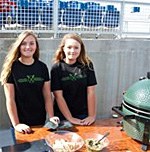Discover the Wines of Southwest France
 Special to Road Trips for Foodies
Special to Road Trips for Foodies
By Wines of Southwest France
In a modern wine landscape that values the offbeat and interesting, wine lovers need not look to far-off lands in order to find unique grape varieties. Dozens of native grapes are hiding in plain sight, tucked into the vineyards of Southwest France’s diverse appellations. Even for in-the-know oenophiles, there’s much to discover from the indigenous grapes behind the characterful wines of Southwest France.
Of the 300 grape varieties grown in Southwest France, 120 are native, some produced throughout the region and others localized to specific pockets of vineyards. The region’s 42 geographical designations stretch from inland vineyards east of the city of Bordeaux, over to the western Atlantic coast, and down to the Pyrénées in the south. This intersection of oceanic, mountain, and continental influences creates a range of individual climates, home to virtually any style of wine: dry or sweet, still or sparkling, white, red, or rosé.
While the average Southwestern French wine won’t include the grape on the front label, getting to know the region’s indigenous varieties will spark a better understanding of each appellation’s wines. These seven offer just a taste to start the journey off right:
* Malbec: This grape produces a unique style wine in its home region of Cahors. Dark, powerful, and age-worthy, Malbec is at its finest in Southwest France.
* Négrette: Aromatic and fruity, Négrette produces charming red and rosé wines in its signature Fronton region.
* Tannat: Tannic and concentrated, Tannat defines the wines of Madiran and provides structure in other regions as well. It can produce showstopping red wines.
* Fer Servadou: A red grape of many names (Braucol in Gaillac, Mansois in Marcillac), Fer Servadou excels throughout Southwest France. It is structured, complex, and often used in blends.
* Mauzac: This chameleon of a grape makes dry, sweet, and sparkling white wines, particularly in its home region of Gaillac.
* Loin de l’Oeil: A tongue-twisting variety from Gaillac, Loin de l’Oeil produces concentrated, fruity wines that can be dry or sweet.
* Gros Manseng: Originally from the western Pyrénées, Gros Manseng is known for making fragrantly fruity, dry or sweet white wines with bright acidity, particularly from Pacherenc du Vic-Bilh and Côtes de Gascogne.
* Semillon: This hidden treasure mostly blended with Sauvignon Blanc is regaining its prestige. In the historical vineyards of sweet wines (Monbazillac and Bergerac) this heritage is carefully maintained. This grape variety brings incomparable notes of candied orange zest, ripe apricots, sometimes mango and passion fruit to the young vintages of sweet wines. When blended with Sauvignon Blanc, it gives flesh and roundness to the dry whites with notes of white peach.
Duras, Prunelard, Petit Manseng, Colombard, Ondenc, Arrufiac, and beyond – the native grapes of Southwest France offer endless discovery.
Interprofession des Vins du Sud-Ouest (IVSO), headquartered in Toulouse, is a professional organization of wine producers, cooperatives, and trading companies in the Southwestern corner of France, bordered by the Atlantic Ocean on the west, and Spain and the Pyrenees Mountains on the south.
Interprofession des Vins de Bergerac Duras is the professional organization of wine producers, cooperatives, and trading companies in the Bergerac Duras. The organization is located in the city of Bergerac in the heart of Bergerac Duras area.
The two Interprofessions, which represent 29 Protected Designation of Origin, 13 Protected Geographical Indication are actively increasing their promotion of the wines of Southwest France in the United States.

















